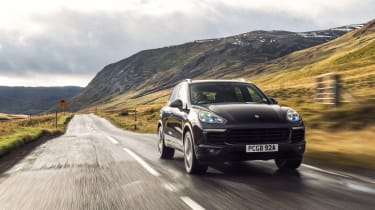Used Porsche Cayenne (2010-2017) – engine, gearbox and technical highlights
Smooth eight-speed gearbox delivers refinement when you want it and response when you fancy pushing the Cayenne harder.
There’s a choice of two diesels: the 258bhp 3.0-litre V6 and the 380bhp 4.2-litre V8, which delivers its huge 627lb ft of torque from 2000 to 2750rpm.
Then there's the E-Hybrid, which uses a lithium-ion traction battery with an energy capacity of 10.9 kWh to enable an electric-only range of 22 miles. With a 94bhp electric motor added to a supercharged 3-litre V6 petrol engine, you get a total of 410bhp.
The pure petrol motors start with the 3.6-litre twin-turbo V6 in the Cayenne S, which develops 414bhp. But it’s the 4.2-litre V8 in the Turbo that hits the largest numbers delivering an extremely generous 513bhp, or a somewhat unhinged 562bhp if you go for the range-topping Turbo S. All models have superbly smooth and fast eight-speed Tiptronic auto transmissions with steering wheel paddle shifters. There is no manual gearbox option.
The driver focused GTS shares the same V6 as the Cayenne S, although it has 22bhp more to make a total of 436bhp. The V6 engine in the Cayenne S sounds rather frenetic and harsh when worked hard. With a little more power and the services of the standard-fit sports exhaust on GTS it sounds far nicer, encouraging you to exploit every one of its 434 horses. No, it doesn’t sound like the original GTS's naturally aspirated V8, and that’s a huge shame, but its growl at full chat and deep burble at lower revs is still appealing.


